Do you have a question about the Mackie 1202 VLZ and is the answer not in the manual?
Quick guide to setting up and using the mixer for immediate playback.
Guidance on how to navigate and understand the manual's layout and features.
Provides additional connection examples and diagrams for various setups.
Details on balanced XLR mic inputs for channels 1-4.
Explanation of phantom power, its function, and important usage warnings.
Description of line-level inputs for channels 1-4, their connectivity, and level adjustment.
Explanation of the low-cut filter function, its frequency, and recommended usage.
Details on the TRIM control for adjusting input sensitivity and gain on channels 1-4.
Information on stereo and mono line inputs for channels 5-12, including jack normalling.
Explains the terms 'serial' and 'parallel' as they relate to effects processing.
Details on using channel insert jacks for serial effects or as direct outputs.
Description of auxiliary return inputs for parallel effects and their usage with stereo or mono devices.
Information on the RCA tape input jacks for connecting tape decks or portable players.
Details on the balanced XLR main outputs, their level capabilities, and wiring.
Explanation of the 30dB pad switch for the XLR main outputs.
Description of 1/4" balanced outputs and unbalanced RCA tape outputs for recording.
Details on headphone, ALT 3/4, and control room outputs and their connectivity.
Information on the 1/4" balanced auxiliary send outputs for effects or monitor mixes.
Explanation of unity gain, the GAIN knob, and their function in setting channel levels.
Functionality of the SOLO and MUTE/ALT 3-4 switches for monitoring and routing.
Details on PAN control for stereo imaging and the 3-band EQ for tonal shaping.
Detailed explanation of the LOW, MID, and HI EQ controls and their frequency responses.
Explanation of AUX SENDs for effects, stage monitoring, and pre/post-fader modes.
Description of the MAIN MIX control and the mixer's Very Low Impedance (VLZ) design.
Details on choosing monitoring sources via the SOURCE matrix switches.
Functionality of monitoring level controls and Pre-Fader Solo for channel inspection.
Explanation of SOLO light, ASSIGN TO MAIN MIX switch, and the metering system.
Details on AUX TALK, AUX 1 SELECT switch, and the AUX 1 MASTER control.
Control of AUX RETURN levels and the EFX TO MONITOR switch function.
Explanation of jack normalling features and their use with EFX TO MONITOR switch.
Instructions for modifying AUX SEND 2 to be pre-fader and pre-mute.
Instructions for modifying AUX SEND 1 and 2 to ignore MUTE/ALT 3-4 switch positions.
Modification to tap the MAIN MIX signal before the level control (pre).
Steps to diagnose and resolve common channel, output, and noise issues.
Instructions for sending the mixer for service, including RA number and shipping details.
Details on XLR, TRS, and TS connector types, their pin assignments, and usage.
Information on RCA connectors and Mackie's specific wiring for inserts and unbalanced connections.
Explanation of flexible stereo usage and using mults/Y-connectors for signal routing.
Benefits of balanced lines and detailed explanation of phantom power for microphones.
Chart outlining proper and improper usage of phantom power with various devices.
Guidelines for proper grounding to ensure safety and minimize noise issues.
Information on how to obtain a free Mackie T-shirt by submitting project details.
Quick guide to setting up and using the mixer for immediate playback.
Guidance on how to navigate and understand the manual's layout and features.
Provides additional connection examples and diagrams for various setups.
Details on balanced XLR mic inputs for channels 1-4.
Explanation of phantom power, its function, and important usage warnings.
Description of line-level inputs for channels 1-4, their connectivity, and level adjustment.
Explanation of the low-cut filter function, its frequency, and recommended usage.
Details on the TRIM control for adjusting input sensitivity and gain on channels 1-4.
Information on stereo and mono line inputs for channels 5-12, including jack normalling.
Explains the terms 'serial' and 'parallel' as they relate to effects processing.
Details on using channel insert jacks for serial effects or as direct outputs.
Description of auxiliary return inputs for parallel effects and their usage with stereo or mono devices.
Information on the RCA tape input jacks for connecting tape decks or portable players.
Details on the balanced XLR main outputs, their level capabilities, and wiring.
Explanation of the 30dB pad switch for the XLR main outputs.
Description of 1/4" balanced outputs and unbalanced RCA tape outputs for recording.
Details on headphone, ALT 3/4, and control room outputs and their connectivity.
Information on the 1/4" balanced auxiliary send outputs for effects or monitor mixes.
Explanation of unity gain, the GAIN knob, and their function in setting channel levels.
Functionality of the SOLO and MUTE/ALT 3-4 switches for monitoring and routing.
Details on PAN control for stereo imaging and the 3-band EQ for tonal shaping.
Detailed explanation of the LOW, MID, and HI EQ controls and their frequency responses.
Explanation of AUX SENDs for effects, stage monitoring, and pre/post-fader modes.
Description of the MAIN MIX control and the mixer's Very Low Impedance (VLZ) design.
Details on choosing monitoring sources via the SOURCE matrix switches.
Functionality of monitoring level controls and Pre-Fader Solo for channel inspection.
Explanation of SOLO light, ASSIGN TO MAIN MIX switch, and the metering system.
Details on AUX TALK, AUX 1 SELECT switch, and the AUX 1 MASTER control.
Control of AUX RETURN levels and the EFX TO MONITOR switch function.
Explanation of jack normalling features and their use with EFX TO MONITOR switch.
Instructions for modifying AUX SEND 2 to be pre-fader and pre-mute.
Instructions for modifying AUX SEND 1 and 2 to ignore MUTE/ALT 3-4 switch positions.
Modification to tap the MAIN MIX signal before the level control (pre).
Steps to diagnose and resolve common channel, output, and noise issues.
Instructions for sending the mixer for service, including RA number and shipping details.
Details on XLR, TRS, and TS connector types, their pin assignments, and usage.
Information on RCA connectors and Mackie's specific wiring for inserts and unbalanced connections.
Explanation of flexible stereo usage and using mults/Y-connectors for signal routing.
Benefits of balanced lines and detailed explanation of phantom power for microphones.
Chart outlining proper and improper usage of phantom power with various devices.
Guidelines for proper grounding to ensure safety and minimize noise issues.
Information on how to obtain a free Mackie T-shirt by submitting project details.
| Channels | 12 |
|---|---|
| Mic Preamps | 4 |
| EQ Bands | 3-band |
| Aux Sends | 2 |
| Phantom Power | Yes |
| Type | Analog |
| Returns | 2 stereo |
| Headphone Output | 1 |
| Weight | 7 lbs |
| Tape Inputs | 1 (stereo) |
| Tape Outputs | 1 (stereo) |

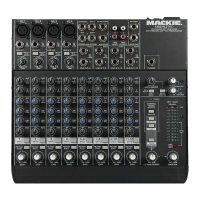

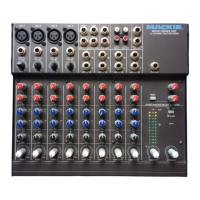
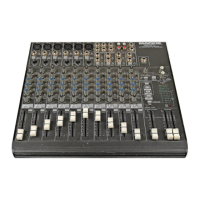



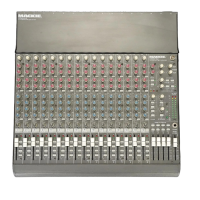

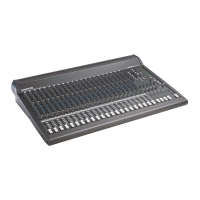
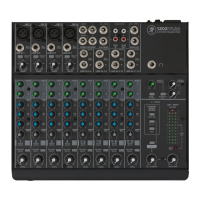
